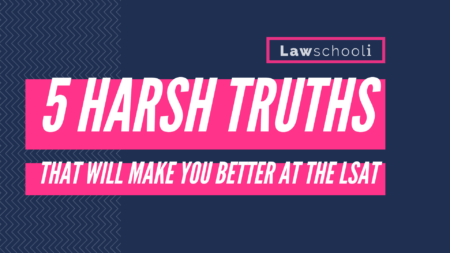In this series of posts, we are taking an in-depth look at strategies that apply to all logical reasoning questions or broad categories of them. Follow these tips and you should be on your way to hitting the best score you can on the LR section.
The Never Ending Debate: Read The Stem or Stimulus First on Logical Reasoning Questions?
The question of whether to read the question stimulus (the part containing the facts, premises, conclusions, etc.) or the stem (the part that actually asks you a question) on LR questions is hotly debated in the LSAT prep community.
Two giants, Powerscore and Kaplan disagree: Powerscore is adamant that you should read the stimulus first and Kaplan is equally sure that you should be reading the stem first.
I used the Logical Reasoning Bible to study for the LR section of the LSAT. I highly recommend buying a copy if you want to maximize your performance on this section of the LSAT.
Click Here to view pricing and reviews on Amazon
There is also a third school of thought out there that you should do whatever is best for you. I believe Manhattan LSAT goes this way. The big problem is there is no real way to tell by trying them both out which is better for you. While one technique might work better at first, it may not be the technique that allows you to go furthest. I think everyone can agree that it would never be a good idea to spend a long time (several weeks) trying the two out. Switching techniques too late in to your prep is likely a bad idea, as your brain will get used to following one or the other. Unlearning techniques on the LSAT is just time wasted.
On LSAT Logical Reasoning Questions, I Read the Stimulus First
My personal story is that I started with the Kaplan stem-first technique just because a Kaplan book was the first LSAT book I cracked. Even though it felt roughly equivalent to skiing backwards, I stuck with it for a little while. About a week later when I opened the Powerscore Logical Reasoning Bible I was relieved that they thought reading the stimulus first was best. This was only about a week in to my study, so switched to that and never looked back. Ultimately I scored 0 wrong on 1 LR section and 1 wrong on the other, so stimulus first definitely worked for me.
Thinking it might help with the analysis, I conducted an informal poll of my now graduated classmates at UChicago. It seems at 80% of the 30 or so polled were stimulus first people, so it is fairly likely that stimulus first is the majority winner at U of C. This is a school where generally everyone was a high LSAT scorer (~170 or better), so we might think that this level of prevalence amounts to a ringing endorsement of the stimulus first approach.
However, I would caution people about drawing too many conclusions from this, as it may mostly reflect the dominance of Powerscore in the LSAT prep world at the time that we all took the test (2008).
Funnily enough, most of the people I asked in my own poll were stubborn defenders of their chosen approach. I heard cogent arguments on both sides, but nothing to sway me from my position.
So Where Does Lawschooli.com Stand in The Stimulus Vs. Stem Debate?
Josh and I are vehement supporters of reading the stimulus first. The LSAT is to me 100% about minimizing the amount of work your brain is doing to process the form of the question. This allows your brain to focus the most it can on the very difficult task of processing the new information that the question is giving you. Reading the question stem first gives your head one more thing to do when it should be focused solely on organizing and learning the new facts that the stimulus presents.
Why We Recommend Reading the LR Stimulus First
By way of analogy, I would say that logical reasoning questions give you a lot of balls to juggle in your head. Say in the stimulus you get two premises and a conclusion to juggle. Why would you want to start off already juggling a ball when you attempt to add these three all at once? It is way better to grasp the premises and conclusion- get good at juggling these initial three- before just adding one more by reading the question stem.
The “Aha” Moment
Here is the best thing about reading stimulus first: you will find as your logical reasoning ability improves that you can often predict what the question stem is going to be before even getting to it. Now this sounds like extra work that your brain is having to do, and you might be asking why not just know upfront instead? Well intuiting the likely question stem is something that starts to come so naturally that I don’t believe it really is any extra work on your brain. Rather it is something that just happens as the information provided in the stimulus clicks in to place.
This powerful intuition is a huge weapon on the test which allows you to really pounce quickly on the right answer much of the time.
By contrast, reading the stem first doesn’t lead to that aha! moment. Instead, you try to fit the facts in with the question type rather than merely focusing on grasping them. I think as often as not you are going to end up rereading the question stem again to be sure about it. Remember you already often have to reread the stimulus- it’s the meat of the question and it’s where LSAC puts the hard work. If you read the stem first, you’ve now jumped back and forth twice over. On a time pressured exam where seconds matter, I think it is sensible to do what you can to minimize that time before you get to the answer choices.
I want to add too that for any one considering reading the stems first in the reading comprehension section, I think that is a terrible idea and should be hardly up for debate. That is clearly way way too much information to juggle. For me, seeing how ridiculous reading questions first would be in the reading comprehension section helps me see the wisdom of reading the stimulus first in LR as well.
Let us also remember that LSAC puts the stimulus and not the stem first on the actual test. I have to believe they did this because they think it is the easier way to process the information.
CAVEAT:
If everything I just wrote strikes you as pure drivel and doing stem first seems just way way more natural to you, then please ignore the above advice and go with stem first. I do think people are wired really differently. Also, both approaches can clearly yield great scores. My real advice is that whatever you decide, make sure you decide it quick and stick with it.
Best of luck and subscribe to us to see more posts on logical reasoning basics rolling out in the next few weeks!
Click the button below for more great LSAT Logical Reasoning study tips.




1 Comment
I am partial to a third, less celebrated approach that combines both schools of thought: Scan the stimulus quickly, stick a fork in the conclusion (if there is one), then read the question stem to see what your job will be. With that, you shouldn’t need to read the stem ever again, and your second read of the stimulus can be more efficient and targeted.
Reading the stimulus carefully and analyzing an argument on the first go-round, without having read the stem, may waste precious time if all you are asked to do is identify the main point. Most of the time, you will have to reread the stimulus anyway, so the initial scan is a good way to prime the pump without wasting precious seconds.